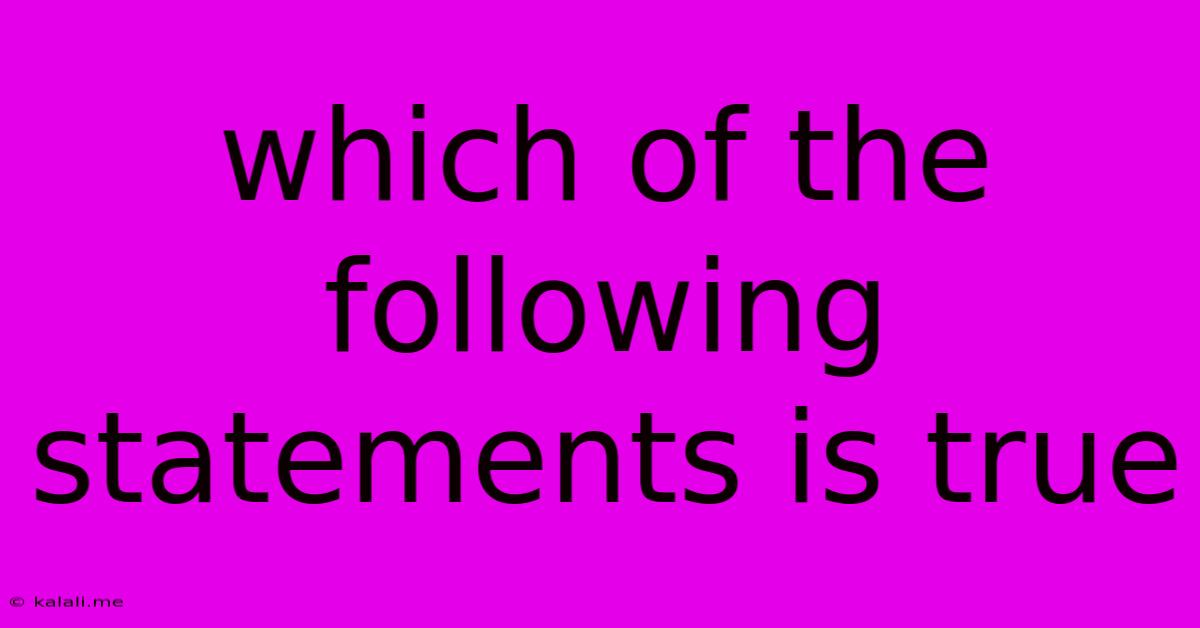Which Of The Following Statements Is True
Kalali
May 20, 2025 · 2 min read

Table of Contents
Determining Truth: A Guide to Evaluating Statements
This article explores the crucial skill of evaluating statements to determine their truthfulness. We often encounter claims, assertions, and arguments in everyday life and need to assess their validity before accepting them as fact. This involves critical thinking, logical reasoning, and a healthy dose of skepticism. Learning to distinguish truth from falsehood is essential for navigating information effectively and making sound judgments.
What Makes a Statement True?
A true statement accurately reflects reality. It corresponds to the facts and can be verified through evidence, observation, or logical deduction. Conversely, a false statement doesn't align with reality and might be based on misinformation, bias, or logical fallacies.
Strategies for Evaluating Statements:
Several strategies can help you determine the truthfulness of a statement:
1. Examine the Evidence:
- Source Credibility: Is the source of the information reputable and trustworthy? Consider the source's expertise, potential biases, and track record of accuracy. A statement from a renowned scientist on a scientific topic holds more weight than an anonymous post on a social media platform.
- Type of Evidence: What kind of evidence supports the statement? Is it anecdotal (based on personal experience), empirical (based on observation and experimentation), or logical (based on reasoning and deduction)? Empirical evidence is generally considered the strongest form of support.
- Evidence Quality: Is the evidence sufficient and relevant? A statement supported by a single, weak piece of evidence is less convincing than one supported by multiple, strong pieces of evidence.
2. Identify Potential Biases:
- Confirmation Bias: We tend to favor information that confirms our pre-existing beliefs. Be aware of this bias and actively seek out opposing viewpoints.
- Cognitive Biases: Various cognitive biases can distort our judgment. Understanding these biases can help us mitigate their influence.
- Motivated Reasoning: People may accept information that supports their desired outcome, even if it's not accurate.
3. Check for Logical Fallacies:
Logical fallacies are errors in reasoning that can make an argument seem convincing even if it's not logically sound. Some common fallacies include:
- Straw Man: Misrepresenting an opponent's argument to make it easier to attack.
- Appeal to Authority: Claiming something is true simply because an authority figure said it.
- Ad Hominem: Attacking the person making the argument instead of the argument itself.
- False Dilemma: Presenting only two options when more exist.
4. Consider the Context:
- Ambiguity: Is the statement clear and unambiguous, or is it open to multiple interpretations?
- Oversimplification: Does the statement oversimplify a complex issue?
- Missing Information: Is there crucial information missing that could alter the statement's truthfulness?
Conclusion:
Determining the truthfulness of a statement requires careful consideration of various factors. By employing these strategies – examining evidence, identifying biases, checking for logical fallacies, and considering the context – you can significantly improve your ability to evaluate information critically and make informed decisions based on accurate and reliable information. This skill is paramount in today's world, where misinformation and disinformation are rampant.
Latest Posts
Latest Posts
-
How To Fill A Pond In
May 21, 2025
-
Cf Card To Sd Card Adapter
May 21, 2025
-
Will Allah Forgive Me For Marrying A Non Muslim
May 21, 2025
-
What Is My Grandads Brother To Me
May 21, 2025
-
Will A Diesel Car Run On Petrol
May 21, 2025
Related Post
Thank you for visiting our website which covers about Which Of The Following Statements Is True . We hope the information provided has been useful to you. Feel free to contact us if you have any questions or need further assistance. See you next time and don't miss to bookmark.